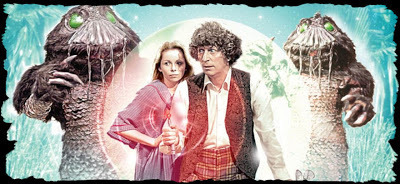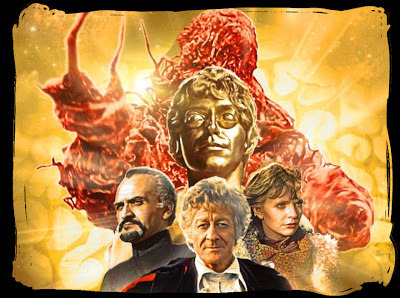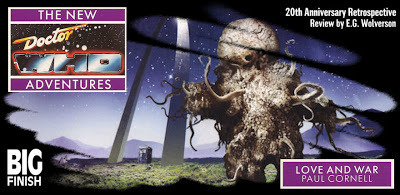E.G. Wolverson's Blog, page 21
March 29, 2013
Book Review | Star Trek: Typhon Pact - Zero Sum Game by David Mack

The literary, and I would imagine also the commercial, success of David Mack’s Star Trek: Destiny trilogy was such that Simon & Schuster would have been missing a trick had they not commissioned another crossover miniseries to follow in its wake. This time around though, the multi-series arc would be longer in length; broader in scope; utilise a number of different authors; and showcase a whole host of different sci-fi subgenres instead of just plain ‘epic’. Star Trek: Typhon Pact’s opening novel, Zero Sum Game, may still come from the pen of Destiny’s author, and may still be almost as fast and as furious a read, but it has far more in common with a Bond movie than it does a Borg one - just substitute our man Bashir for 007, the eponymous Typhon Pact for the USSR and the United Federation of Planets for the Western world. And fortunately for Mack, nobody does it better.
But for its “Typhon Pact” subtitle, Zero Sum Game would otherwise have been billed as a Deep Space 9 novel. Not only does its cover bear the images of two of its star-crossed alumni, but its plot and its tone are both firmly rooted in the DS9 house style. After a relatively short reintroduction to the station’s chief medical officer, Dr Julian Bashir - who is now as lonely and as lovelorn as ever he was on television, if not even more so -, Mack turns to the series’ ‘Jack Pack’ of genetically-engineered misfits (from Statistical Probabilities and Chrysalis) to brief Bashir on his secret mission for Starfleet Intelligence, and, more importantly, to introduce him to his partner in the field: his fellow superhuman, former patient and long lost love, Sarina Douglas. Together they must infiltrate a Breen enclave and sabotage the Typhon Pact’s development of a quantum slipstream starship, the specs for which were stole from Utopia Planitia Fleet Yards. The only trouble is, Starfleet Intelligence knows little more about the Breen than most Star Trek viewers do - and most of that is conflicting.
Much of this novel’s success is attributable to Mack’s depiction of the Breen culture, which until now has had an alluring question mark hovering above it. On the rare instances that they were seen in Deep Space 9, usually as part of the Dominion, the Breen looked like less-weathered versions of Return of the Jedi’s Princess Leia in her Boushh disguise, and their unintelligible mechanical shrieks only added to their utterly alien an unerringly uniform mystique. Zero Sum Game lifts the veil on ‘Breen’, but each reveal only begs further questions and deepens the intrigue. Once those porcine masks are lifted, Mack introduces us to complex characters ranging from dissidents living in underground warrens to an overworked slipstream engineer who has to worry as much about politics as he does quantum equations, and whom the reader comes to care for and sympathise with almost as much as Bashir and Sarina. Behind them, he paints in a society predicated on anonymity and fairness, where anti-nepotism and equality are championed above revealing one’s face to a neighbour or colleague. Indeed, what begins the novel as an unequivocally-antagonistic confederacy ends it as a fascinating, layered and above all else grey civilisation; as fate urges the patriotic Bashir to reluctantly exercise his Federation-sanctioned licence to kill against Breen civilians (as well as militia), Mack forces us to look at the good doctor’s “murders” through Breen eyes. In this respect, Zero Sum Game is more than just another chapter in Deep Space 9’s ‘Bashir plays Bond’ storyline – it’s a cold look at cold war, Hippocratic Oaths in tatters and the paving on the road to Hell. It’s a case study of two diametrically-opposed planetary unions – one whose citizens wear metallic masks, one whose citizens where ethical ones.
Which brings me to Sarina, this novel’s genetically-enhanced Bond girl. The sweet butterfly that Bashir coaxed out of her cocoon on television is now an über-capable femme fatale with a surprising hair trigger, lack of compassion and newfound penchant for promiscuity. Despite Mack’s omniscient prose offering us occasional windows into her thoughts, she remains as inscrutable as the Breen that she’s sent to infiltrate, and I dare say a little colder. Having watched Alexander Siddig take Bashir from the wet-behind-the-ears pompous lieutenant of Emissary to the stiff-upper-lipped, lonely old backbone of a space station at war, I would’ve thought that I’d like nothing more than to read about him finally get the girl of his dreams – particularly if he was able to win her heart amidst the perils of undercover intelligence work, which would have really played to his sense of romance. When it happens though, it feels too easy; too flat; too hollow. Lost in the pages, I found myself waiting for a catastrophe to come and crush the Doctor’s fleeting happiness, but it seems that Mack has something altogether more interesting in store for the couple – a long game that is only just beginning in this book.
While for the most part, Mack’s narrative sticks with Bashir and Sarina, it occasionally breaks away to follow Captain Ezri Dax and the crew of the Aventine, who have been charged with extracting the two smitten spies should their mission succeed. However, before they can even formulate a rescue plan, let alone implement one, they need to shake off the cloaked Romulan warbird on their tail and evade a Breen fleet. Reading these parts of the story, I was put in mind of the Star Trek: The Next Generation two-parter Unification, as little happens involving the Aventine to further the fundamental storyline or even significantly heighten the tension; I found myself constantly willing Mack to cut the padding and return to the two protagonists. This is a pity, really, as I feel that Mack could have done more with Dax than just show what a damned effective captain she’s become – the novel’s cover artwork hinted at an exploration of the failed romantic relationship between Bashir and Dax, which of course becomes even more strained with Sarina’s return, but this is broached only through a quick meal and a row at the novel’s start. I had at least expected a little more insight into Dax’s thoughts as she sought to recover the spy who once loved her.
Taken as a whole though, Zero Sum Game is a real page-turner of a tome; one that took me far less time to tear through than most Star Trek novels, laden as it is with love, lure and good old-fashioned adventure. Mack’s sense of pace is perfect, his action-packed prose is every bit as vivid as a movie screen and his portrait of the Typhon Pact-founding Breen sets the bar so high that I fear for the authors who must follow him as they seek to flesh out the hitherto-uncharted Tzenkethi Coalition, Gorn Hegemony, Tholian Assembly and Holy Order of the Kinshaya in subsequent volumes. With the Borg threat apparently put paid to once and for all, and the United Federation of Planets a mere shadow of its former self, for the first time since the Dominion War, 24th century-Trek feels fresh and exciting. The Typhon Pact might be built around the well-trodden Romulan Star Empire, but its Alpha Quadrant allies are as untapped as the races that Captain Eden’s Voyager fleet is seeking out on the other side of the galaxy. The franchise continues to go boldly where none have gone before; the fact that such places lurk just around the cosmic corner only adds to its appeal, rather than detracts from it.
Published on March 29, 2013 15:26
March 21, 2013
The One-Listen Lowdown | Bloodsports by Suede
 After an absence of more than a decade, Suede returned to the music scene this Monday with their sixth studio album, Bloodsports.Thanks to a couple of cash-in collections and a short-lived but fruitful Anderson / Butler reconciliation that brought us the Tears, it doesn’t feel like eleven years have passed since the band’s last substantial offering, and, happily, it doesn’t sound like it either. Bloodsportsquite intentionally lurks in the lacuna between the cinematic grandeur of Dog Man Star and the colourful kitsch of Coming Up, offering listeners a fat-free and apparently effortless resurrection of Suede at the height of their powers – radio-friendly, yes, but not at the expense of the deep and carnal themes that underpin almost every track.
After an absence of more than a decade, Suede returned to the music scene this Monday with their sixth studio album, Bloodsports.Thanks to a couple of cash-in collections and a short-lived but fruitful Anderson / Butler reconciliation that brought us the Tears, it doesn’t feel like eleven years have passed since the band’s last substantial offering, and, happily, it doesn’t sound like it either. Bloodsportsquite intentionally lurks in the lacuna between the cinematic grandeur of Dog Man Star and the colourful kitsch of Coming Up, offering listeners a fat-free and apparently effortless resurrection of Suede at the height of their powers – radio-friendly, yes, but not at the expense of the deep and carnal themes that underpin almost every track. Its opening song, “Barriers”, typifies this euphonious synthesis perhaps as well as any other. Brett Anderson’s still-soaring vocals (“Aniseed kisses and lipstick traces…”) are complemented by a mounting rock sound that, by the track’s end, has risen to the level of Steinman-esque grandeur that one would expect to find on a Killers album. It’s little wonder that the band gave this track away as a taster single, such is its lure. “Snowblind” maintains the momentum, not to mention the aniseed fixation, presenting a crisp, commercial – if a little anodyne, compared to the rest of the LP –sound that I would imagine will see it appear as a single before too long.
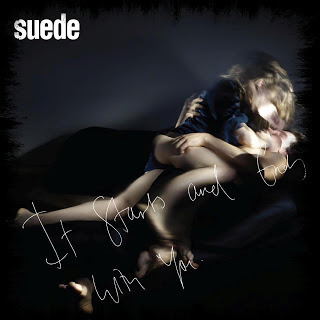 The album’s third track sets things spinning faster, as “It Starts and Ends with You” reminds us why Suede were one of the biggest singles bands of the 1990s. A delectable blend of lyrical inventiveness (“Like a hairline crack on a radiator, leaking life…”) and glorious cliché (“And I fall to the floor like my strings are cut…”) sit atop one of Richard Oakes’ finest guitar melodies, perhaps making Bloodsports’ first commercial single the group’s most memorable since 1996’s instantly-recognisable “Beautiful Ones”. It is followed by “Sabotage” – an edgy and experimental track that’s been built like a b-side, which in Suede’s case is more of a compliment that a criticism, particularly in an era where digital technology has effectively put paid to such outmoded pleasures. There was a time when the release of a new Suede single would amount to almost an album’s worth of new material if one purchased all its cross-media releases, and it was material that stood up against – and in a few cases, surpassed – the better-known a-sides and album tracks. “For the Strangers” is cut from similarly eerie cloth, and with all its talk of aerosol, “gutters and drains and bins” is every bit as redolent of Suede’s popular mid-’90s stuff. “Hit Me” is the imperative chosen to name Bloodsports’ sixth track, but in truth it’s the song that does all the hitting, setting itself up as a sure-fire future single with its guitar-driven aggression and lyrical spite.
The album’s third track sets things spinning faster, as “It Starts and Ends with You” reminds us why Suede were one of the biggest singles bands of the 1990s. A delectable blend of lyrical inventiveness (“Like a hairline crack on a radiator, leaking life…”) and glorious cliché (“And I fall to the floor like my strings are cut…”) sit atop one of Richard Oakes’ finest guitar melodies, perhaps making Bloodsports’ first commercial single the group’s most memorable since 1996’s instantly-recognisable “Beautiful Ones”. It is followed by “Sabotage” – an edgy and experimental track that’s been built like a b-side, which in Suede’s case is more of a compliment that a criticism, particularly in an era where digital technology has effectively put paid to such outmoded pleasures. There was a time when the release of a new Suede single would amount to almost an album’s worth of new material if one purchased all its cross-media releases, and it was material that stood up against – and in a few cases, surpassed – the better-known a-sides and album tracks. “For the Strangers” is cut from similarly eerie cloth, and with all its talk of aerosol, “gutters and drains and bins” is every bit as redolent of Suede’s popular mid-’90s stuff. “Hit Me” is the imperative chosen to name Bloodsports’ sixth track, but in truth it’s the song that does all the hitting, setting itself up as a sure-fire future single with its guitar-driven aggression and lyrical spite. 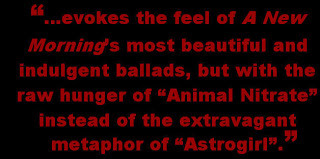 However, it’s the album’s final four tracks that offer the listener the greatest reward, as is immediately evident from the opening refrain of “Sometimes I Feel I’ll Float Away”, which evokes the feel of A New Morning’s most beautiful and indulgent ballads, but with the raw hunger of “Animal Nitrate” instead of the extravagant metaphor of “Astrogirl”. “All the plans were made in the wooded glade,” Anderson sings. “Where your body was split wide open, and I count to ten as the race begins round your hairpin bends.” Brutal and honest.
However, it’s the album’s final four tracks that offer the listener the greatest reward, as is immediately evident from the opening refrain of “Sometimes I Feel I’ll Float Away”, which evokes the feel of A New Morning’s most beautiful and indulgent ballads, but with the raw hunger of “Animal Nitrate” instead of the extravagant metaphor of “Astrogirl”. “All the plans were made in the wooded glade,” Anderson sings. “Where your body was split wide open, and I count to ten as the race begins round your hairpin bends.” Brutal and honest.“What Are You Not Telling Me?” continues the record’s rapid descent into off-kilter love song, as telephones’ “brittle sighs” and “blown-away dandelion clocks” segue into poetic musings on the mysteries of love – not the romantic, abstract mysteries of which the masses sing, but the day-to-day “little things that are tearing us up”. With a few more listens, this one has the potential to rival REM’s “The One I Love” as one of my favourite twisted love songs.
 The penultimate offering, “Always”, is another prominent example of vintage Suede, and it’s one to which every single member of the current ensemble contributed something in the writing. Magnificently capturing the disturbing nature of unrequited love, Anderson’s string of similes is laced with silent menace. “Like a sniper in the wings,” the lovelorn protagonist wails, “I will always be near.” Cue restraining order. Bloodsports’final song then shifts its focus back to reciprocal love, albeit in a world gone to the dogs. Whereas the two proceeding tracks dwell on distrustful relationships and unwanted attachment, “Faultlines” is a much more idealistic piece about two lovers whose mutual affection brings light into a world of “wreckage” where car alarms drown out birdsong. It’s hauntingly apposite in 2013.
The penultimate offering, “Always”, is another prominent example of vintage Suede, and it’s one to which every single member of the current ensemble contributed something in the writing. Magnificently capturing the disturbing nature of unrequited love, Anderson’s string of similes is laced with silent menace. “Like a sniper in the wings,” the lovelorn protagonist wails, “I will always be near.” Cue restraining order. Bloodsports’final song then shifts its focus back to reciprocal love, albeit in a world gone to the dogs. Whereas the two proceeding tracks dwell on distrustful relationships and unwanted attachment, “Faultlines” is a much more idealistic piece about two lovers whose mutual affection brings light into a world of “wreckage” where car alarms drown out birdsong. It’s hauntingly apposite in 2013. “A return to form” seems to be the music world’s collective reception to Bloodsports, but – save for their mostly-flat Singles-era offerings – I don’t think that that Suede ever went off the boil; they just got lost in TV and aberrant positivity. This record, though, sees the band lost to the bloody ravages of love once more, their songs capturing all the anger, alienation and untied amour of a world happy to push light BDSM in its mummy porn. Wipe away those Tears; Suede are back and better than ever.
Published on March 21, 2013 12:40
February 26, 2013
iTunes TV Show Review | Partrimilgrimage - The Alan Partridge Specials
 My love affair with Apple products is sullied somewhat by the iTunes Store’s habitual overpricing of video content – as a general rule, I can buy a high-definition blu-ray for a fraction of the price of an iTunes standard-definition download. However, I’ve recently found my way to a few baffling bargains, ranging from the Outnumbered and Doctor Who Christmas specials in HD for just a couple of quid to a Partridge in a maple tree – or, that is, an HD Partrimilgrimage for a mere £3.99.
My love affair with Apple products is sullied somewhat by the iTunes Store’s habitual overpricing of video content – as a general rule, I can buy a high-definition blu-ray for a fraction of the price of an iTunes standard-definition download. However, I’ve recently found my way to a few baffling bargains, ranging from the Outnumbered and Doctor Who Christmas specials in HD for just a couple of quid to a Partridge in a maple tree – or, that is, an HD Partrimilgrimage for a mere £3.99.Originally broadcast on Sky Atlantic last summer, this collection of Alan Partridge oddities defies expectations as well as pronunciation. After being a little disappointed with his Mid Morning Matters, I was delighted to see the erstwhile Knowing Me, Knowing You presenter back at the top of his vainglorious game as he introduced viewers to his native Norfolk – or, as he so logically puts it, the “Wales of the East” – in the bundle’s first instalment, Welcome to the Places of My Life.
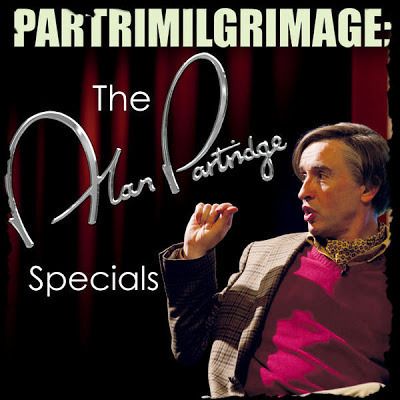
Punctuated with blasts of what sounds like a cross between Steeleye Span and a pissed Steve Coogan on karaoke, this travelogue exudes pomp and vanity throughout, and probably contains as many barbed Partridge one-liners in its forty minutes as did the whole series of Mid Morning Matters. Whether he’s clarifying that the “home of the Broads” isn’t an allusion to a “refuge for fallen prostitutes” (fallen prostitutes?), or likening the black death to HIV, only airborne – “Let me put that in context for you: flying AIDS!” – Partridge is more despicable than he’s ever been, and this time there’s nobody to rein him in. With his days at the BBC long behind him, Welcome to the Places of My Lifewas produced by Partridge’s own Pear Tree Productions – a truth that is shamelessly evident from the programme’s first substantive interview, which employs the clumsiest of editing techniques to try and mask Partridge’s weakness as a swimmer. Such trickery presents itself again later in the show, as a pensive vicar’s pauses are dramatically curtailed in post-production – so brutally so, in fact, that for a moment I thought my Apple TV had started dropping frames. What really stings is that the poor clergyman’s pauses might not have been so protracted, had he not been faced with questions and challenges such as “What do you think a soul looks like? Draw one!”
 My favourite part of the programme though is the segment that sees Partridge begrudgingly try to broach the class divide. Fancying himself as a market grocer, down-to-earth Alan decides to turn his hand to selling fruit – a task that the gently-joshing stallholders don’t expect him to succeed in, much to his disgust. “It’s menial work,” he spits, before waxing lyrical in a voiceover about how selling fruit was one of the easiest things he’s ever done, but without providing any convincing visual evidence of an actual sale. And, heckles raised, Partridge doesn’t stop there, launching himself into one of his disproportionately vicious – and highly amusing – verbal slammings. “These stallholders, with their fast and loose approach to grammar, and particularly their cavalier use of apostrophes, were clearly people living on the very fringes of society,” he warns with undue horror, no doubt having forgotten his omission of the hyphen in mid-morning when he begat Mid Morning Matters.
My favourite part of the programme though is the segment that sees Partridge begrudgingly try to broach the class divide. Fancying himself as a market grocer, down-to-earth Alan decides to turn his hand to selling fruit – a task that the gently-joshing stallholders don’t expect him to succeed in, much to his disgust. “It’s menial work,” he spits, before waxing lyrical in a voiceover about how selling fruit was one of the easiest things he’s ever done, but without providing any convincing visual evidence of an actual sale. And, heckles raised, Partridge doesn’t stop there, launching himself into one of his disproportionately vicious – and highly amusing – verbal slammings. “These stallholders, with their fast and loose approach to grammar, and particularly their cavalier use of apostrophes, were clearly people living on the very fringes of society,” he warns with undue horror, no doubt having forgotten his omission of the hyphen in mid-morning when he begat Mid Morning Matters.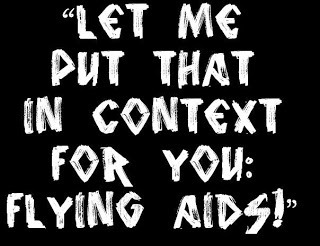 But as a man “whose statutory rights are important” to him, Partridge doesn’t dwell long in the marketplace, quickly moving on to a car dealership where he finds himself a Range Rover to test-drive, a vehicle that he’s keen to stress is male -“I’m not driving a girl!”-, in so doing eschewing the centuries-old tradition of feminising transport. Scenes of Partridge and an unfortunate salesman trying to talk over each other as they wind around country lanes, firing their trenchant views on automatic and manual differential locks at each other, are woven betwixt guides to skiing in England’s flattest county; child actors admiring “substitute trees” in illusion-wrecked flashbacks to Partridge’s youth; and even Partridge’s stab at being Andrew Marr as he dramatises “historic” events occurring inside Norwich City Hall, such as the furore caused by the proposed extension to city centre parking fees beyond 7pm. It’s all vintage Partridge, but fresh and in 1080p.
But as a man “whose statutory rights are important” to him, Partridge doesn’t dwell long in the marketplace, quickly moving on to a car dealership where he finds himself a Range Rover to test-drive, a vehicle that he’s keen to stress is male -“I’m not driving a girl!”-, in so doing eschewing the centuries-old tradition of feminising transport. Scenes of Partridge and an unfortunate salesman trying to talk over each other as they wind around country lanes, firing their trenchant views on automatic and manual differential locks at each other, are woven betwixt guides to skiing in England’s flattest county; child actors admiring “substitute trees” in illusion-wrecked flashbacks to Partridge’s youth; and even Partridge’s stab at being Andrew Marr as he dramatises “historic” events occurring inside Norwich City Hall, such as the furore caused by the proposed extension to city centre parking fees beyond 7pm. It’s all vintage Partridge, but fresh and in 1080p. The collection’s second episode sees Partridge appear on Open Books with Martin Bryce, where he’s interviewed by fellow author Chris Beale – a man whom Partridge has so little respect for, he can’t even get his name right, let alone make any sort of positive comment about his work. Studio-bound and slower burning by nature, the intimacy of the programme highlights every awkward silence; the lack of spectacle causes every Partridge faux-pas to linger for longer. Of course, as a reader (and reviewer) of
I,Partridge: We Need to Talk About Alan
, inevitably its author’s emotive readings didn’t engross me as much as they would have someone who has yet to tackle the tome, but there was still plenty to entertain me here as Partridge’s transparent stooges and obsessive fan (singular!) make their respective presences felt, and Partridge shares his plans for his next book – a “What if…?” novel set on board the RMS Titanic, designed both to commemorate the hundredth anniversary of its stinking and to make a powerful statement against speed cameras.
The collection’s second episode sees Partridge appear on Open Books with Martin Bryce, where he’s interviewed by fellow author Chris Beale – a man whom Partridge has so little respect for, he can’t even get his name right, let alone make any sort of positive comment about his work. Studio-bound and slower burning by nature, the intimacy of the programme highlights every awkward silence; the lack of spectacle causes every Partridge faux-pas to linger for longer. Of course, as a reader (and reviewer) of
I,Partridge: We Need to Talk About Alan
, inevitably its author’s emotive readings didn’t engross me as much as they would have someone who has yet to tackle the tome, but there was still plenty to entertain me here as Partridge’s transparent stooges and obsessive fan (singular!) make their respective presences felt, and Partridge shares his plans for his next book – a “What if…?” novel set on board the RMS Titanic, designed both to commemorate the hundredth anniversary of its stinking and to make a powerful statement against speed cameras.Equidistant between An Idiot Abroad and I’m Alan Partridge, this Partrimilgrimage is one metaphysical journey worth making. And for £3.99, it’s cheaper than the trek to Bodh Gaya. Or, for that matter, Cromer.
Published on February 26, 2013 03:56
February 24, 2013
DVD Review | Doctor Who - Nightmare of Eden
Published on February 24, 2013 04:49
February 19, 2013
Blu-ray Review | Rock vs Cena - Once in a Lifetime
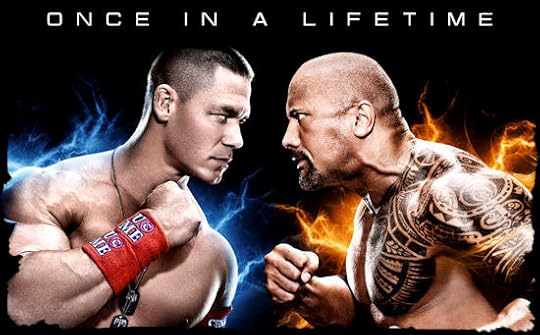 The Rock’s departure from the wrestling world in 2003 (or 2004, if you count the one-off WrestleMania XX Rock ’n’ Sock reunion) coincided with my rapidly-diminishing interest in the World Wrestling Entertainment product, and there’s no coincidence there. Arguably ‘Stone Cold’ Steve Austin was the face of the then-World Wrestling Federation’s golden Attitude Era, but it’s often overlooked that he missed most of 2000 through injury, and soon after his return suffered an initially-shocking but ultimately-flawed heel turn – nobody wanted to hate “The Most Popular Superstar of All Time”, particularly when he made for the most amusing (and musical...) of baddies the second time around. The Rock, on the other hand, was there almost every week to electrify the masses. Heel or face, behind the mic or in the ring, the Brahma Bull was an act that nobody wanted to miss – but miss him they did, once he’d packed his bags for Hollywood.
The Rock’s departure from the wrestling world in 2003 (or 2004, if you count the one-off WrestleMania XX Rock ’n’ Sock reunion) coincided with my rapidly-diminishing interest in the World Wrestling Entertainment product, and there’s no coincidence there. Arguably ‘Stone Cold’ Steve Austin was the face of the then-World Wrestling Federation’s golden Attitude Era, but it’s often overlooked that he missed most of 2000 through injury, and soon after his return suffered an initially-shocking but ultimately-flawed heel turn – nobody wanted to hate “The Most Popular Superstar of All Time”, particularly when he made for the most amusing (and musical...) of baddies the second time around. The Rock, on the other hand, was there almost every week to electrify the masses. Heel or face, behind the mic or in the ring, the Brahma Bull was an act that nobody wanted to miss – but miss him they did, once he’d packed his bags for Hollywood.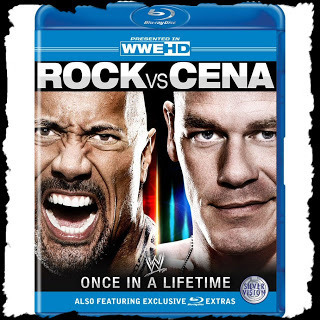 But as the Rock rose from being the mere “Most Electrifying Man in Sports-Entertainment” to the “Most Electrifying Man in All of Entertainment”, a blue-collar kid from Massachusetts was turning from a robotic prototype into a one-man franchise. Post-brand extension WWE was desperate for a new poster boy, and the freestyling John Cena not only became the company’s new face, but soon put a smile on it, winning a record number of WWE Championships on both the RAW and SmackDown! brands. Just as Hulk Hogan had dominated the 1980s and early 1990s, and the Rock the late 1990s and early 2000s, John Cena has reigned supreme since 2005, his smile only subsiding whenever he’d take a moment to stop and disparage Dwayne ‘The Rock’ Johnson – the man who walked out on the business that’s become Cena’s raison d’être.
But as the Rock rose from being the mere “Most Electrifying Man in Sports-Entertainment” to the “Most Electrifying Man in All of Entertainment”, a blue-collar kid from Massachusetts was turning from a robotic prototype into a one-man franchise. Post-brand extension WWE was desperate for a new poster boy, and the freestyling John Cena not only became the company’s new face, but soon put a smile on it, winning a record number of WWE Championships on both the RAW and SmackDown! brands. Just as Hulk Hogan had dominated the 1980s and early 1990s, and the Rock the late 1990s and early 2000s, John Cena has reigned supreme since 2005, his smile only subsiding whenever he’d take a moment to stop and disparage Dwayne ‘The Rock’ Johnson – the man who walked out on the business that’s become Cena’s raison d’être. Over the years, many of the finest feuds in professional wrestling have been those borne of real heat. Bret Hart and Shawn Michaels? By the mid-1990s they hated each other even more than their wrestling characters professed, culminating in Michaels’ involvement in the real-life 1997 “screwjob” in Montreal at that year’s Survivor Series. Matt Hardy and Edge? The latter stole the former’s girlfriend while he had a broken neck, and then went onto superlative success as the self-styled “Rated-R Superstar” while his adversary sat unemployed at home. But John Cena and the Rock is, in my view, an altogether more interesting proposition. Both were, at their respective heights, the company’s biggest babyfaces, yet both of them have drawn boos from crowds for showing the very qualities that made them heroes. In the Rock’s case, his initial eagerness to please soon turned an audience unwittingly headed for the Attitude Era squarely against him – a trend he quickly bucked by ditching his squeaky-clean “Rocky Maivia” gimmick and becoming the jabroni-beating, pie-eating, trail-blazing, eyebrow-raising Rock that we all knew and loved. But in Cena’s case, he was a hands-down fan favourite right from his first big push, only to gradually build up an increasing number of detractors as he enjoyed more and more success. This is unheard of, really, when you consider the length of time that Cena has been at the top, and particularly the out-and-out irreproachability of his actions during that time. This isn’t an old-fashioned good guy with a superiority complex, á la Kurt Angle – he’s a straight-talking, hard-working and often immodest performer who, by all rights, should be a firm fan favourite. The Rock, conversely, is by turns overbearing, hypocritical and downright mean. There was a reason he played the villain when he rejoined the RAW roster for a couple of months in 2003 – nobody could forgive him for leaving the squared circle. He was effectively booed out of SummerSlam 2002, having dropped his then-Undisputed WWE Championship to the so-called “Next Big Thing”, Brock Lesnar. But upon his return to the now-HD, widescreen WWE Universe, fans worldwide instantly turned their back on the leader of Cenation, vilifying him for his unfashionable constancy and instantly getting behind their intermittently-attending, but undoubtedly exhilarating, “People’s Champion”.
Over the years, many of the finest feuds in professional wrestling have been those borne of real heat. Bret Hart and Shawn Michaels? By the mid-1990s they hated each other even more than their wrestling characters professed, culminating in Michaels’ involvement in the real-life 1997 “screwjob” in Montreal at that year’s Survivor Series. Matt Hardy and Edge? The latter stole the former’s girlfriend while he had a broken neck, and then went onto superlative success as the self-styled “Rated-R Superstar” while his adversary sat unemployed at home. But John Cena and the Rock is, in my view, an altogether more interesting proposition. Both were, at their respective heights, the company’s biggest babyfaces, yet both of them have drawn boos from crowds for showing the very qualities that made them heroes. In the Rock’s case, his initial eagerness to please soon turned an audience unwittingly headed for the Attitude Era squarely against him – a trend he quickly bucked by ditching his squeaky-clean “Rocky Maivia” gimmick and becoming the jabroni-beating, pie-eating, trail-blazing, eyebrow-raising Rock that we all knew and loved. But in Cena’s case, he was a hands-down fan favourite right from his first big push, only to gradually build up an increasing number of detractors as he enjoyed more and more success. This is unheard of, really, when you consider the length of time that Cena has been at the top, and particularly the out-and-out irreproachability of his actions during that time. This isn’t an old-fashioned good guy with a superiority complex, á la Kurt Angle – he’s a straight-talking, hard-working and often immodest performer who, by all rights, should be a firm fan favourite. The Rock, conversely, is by turns overbearing, hypocritical and downright mean. There was a reason he played the villain when he rejoined the RAW roster for a couple of months in 2003 – nobody could forgive him for leaving the squared circle. He was effectively booed out of SummerSlam 2002, having dropped his then-Undisputed WWE Championship to the so-called “Next Big Thing”, Brock Lesnar. But upon his return to the now-HD, widescreen WWE Universe, fans worldwide instantly turned their back on the leader of Cenation, vilifying him for his unfashionable constancy and instantly getting behind their intermittently-attending, but undoubtedly exhilarating, “People’s Champion”. Usually when I watch a WWE home video, I’ve seen all the ancient matches and so just focus on the documentary. This was the case when I watched The Epic Journey of Dwayne ‘The Rock’ Johnson, and I firmly expected it to be the case when I popped in the first disc of Rock vs Cena - Once in a Lifetime (a misnomer if ever there was one, given this year’s anticipated rematch), which picks up more or less exactly where the former left off – the Rock’s return to RAW just prior to WrestleMania XVII, which he would go on to host. However, this release’s supposedly-centrepiece documentary feels like a token bonus feature; a fleeting look behind the scenes of the 6-hour epic that unfurls across the two discs in dazzling 1080p, blow by blow. As I didn’t follow this iconic rivalry live, I can’t say for sure that this blu-ray presents every single Rock / Cena showdown on the road to WrestleMania XVIII in Miami, but it certainly doesn’t feel like anything has been excluded. I sat enthralled for hours as these two giants fired scathing promos - and, believe it or not, tweets - at each other; reluctantly teamed up against the Miz and R-Truth, a pair of good ol’ fashioned baddies; and eventually set the Showcase of the Immortals alight with undoubtedly the biggest match since Rock and Hollywood Hogan - and arguably one of the best too. I couldn’t help but feel for Cena when his unassailable arguments against the Rock fell flat with the rabid RAW audience, who lapped up every rapidly-trending soundbite (“John Cena’s got lady parts…” / “Fruity Pebbles…”) Rocky used to mask the inherent paucity of his - when he deigned to show up, that is. The events housed on these discs don’t take place over a month or two, as most big-match build-ups do – the Rock’s appearances are peppered across more than a year, an innovation in storytelling that, in of itself, sets this feud apart from any other before or since.
Usually when I watch a WWE home video, I’ve seen all the ancient matches and so just focus on the documentary. This was the case when I watched The Epic Journey of Dwayne ‘The Rock’ Johnson, and I firmly expected it to be the case when I popped in the first disc of Rock vs Cena - Once in a Lifetime (a misnomer if ever there was one, given this year’s anticipated rematch), which picks up more or less exactly where the former left off – the Rock’s return to RAW just prior to WrestleMania XVII, which he would go on to host. However, this release’s supposedly-centrepiece documentary feels like a token bonus feature; a fleeting look behind the scenes of the 6-hour epic that unfurls across the two discs in dazzling 1080p, blow by blow. As I didn’t follow this iconic rivalry live, I can’t say for sure that this blu-ray presents every single Rock / Cena showdown on the road to WrestleMania XVIII in Miami, but it certainly doesn’t feel like anything has been excluded. I sat enthralled for hours as these two giants fired scathing promos - and, believe it or not, tweets - at each other; reluctantly teamed up against the Miz and R-Truth, a pair of good ol’ fashioned baddies; and eventually set the Showcase of the Immortals alight with undoubtedly the biggest match since Rock and Hollywood Hogan - and arguably one of the best too. I couldn’t help but feel for Cena when his unassailable arguments against the Rock fell flat with the rabid RAW audience, who lapped up every rapidly-trending soundbite (“John Cena’s got lady parts…” / “Fruity Pebbles…”) Rocky used to mask the inherent paucity of his - when he deigned to show up, that is. The events housed on these discs don’t take place over a month or two, as most big-match build-ups do – the Rock’s appearances are peppered across more than a year, an innovation in storytelling that, in of itself, sets this feud apart from any other before or since.
 But here’s the thing - as their hyped-to-the-hilt WrestleMania match pulled towards its spectacular finish, each man enduring finisher after finisher only to get a shoulder up at two, I wanted to see the Rock layeth the smacketh down - just like I wanted him to make the loveable, sock-wielding Mankind say “I quit! ”; just like I wanted him to drop the People’s Elbow on the renaissance Hulkster; just like I wanted him to end Austin’s career with a Rock Bottom. Why? Because he’s the Rock - the most entertaining sports entertainer that ever there was, and for all John Cena’s virtues, neither he nor anyone else could ever hope to compete with that. Let’s hope that he can continue to rise above it...
But here’s the thing - as their hyped-to-the-hilt WrestleMania match pulled towards its spectacular finish, each man enduring finisher after finisher only to get a shoulder up at two, I wanted to see the Rock layeth the smacketh down - just like I wanted him to make the loveable, sock-wielding Mankind say “I quit! ”; just like I wanted him to drop the People’s Elbow on the renaissance Hulkster; just like I wanted him to end Austin’s career with a Rock Bottom. Why? Because he’s the Rock - the most entertaining sports entertainer that ever there was, and for all John Cena’s virtues, neither he nor anyone else could ever hope to compete with that. Let’s hope that he can continue to rise above it...
Published on February 19, 2013 13:20
January 29, 2013
DVD Review | Doctor Who - The Claws of Axos (Special Edition)
Published on January 29, 2013 01:57
December 23, 2012
A Supersize Christmas Present
 From Christmas Eve morning until Boxing Day night, the first of my comic morality tales for children, Supersize vs Superskinny Santa, will be available to download free of charge from Amazon’s Kindle Store (usual price £1.99). UK readers can download the book by following this link.
From Christmas Eve morning until Boxing Day night, the first of my comic morality tales for children, Supersize vs Superskinny Santa, will be available to download free of charge from Amazon’s Kindle Store (usual price £1.99). UK readers can download the book by following this link.The picture book can be read in full colour on a Kindle Fire, iPhone, iPad, Android, Windows Phone 7 or any PC, Mac or laptop with the appropriate software installed (visit the Kindle Store to download the appropriate free app for your device). Those with older black and white Kindles are still able to enjoy the book, albeit in monochrome.
I would be very grateful if you could let people that you think might be interested in it know about the book and, if you can, post links to it. If you’ve enjoyed it yourself, please also consider writing a review or clicking the ‘like’ button. Reviews especially would be appreciated.
Published on December 23, 2012 06:59
December 20, 2012
Technology Review | At War with Bananaman: An Idiot’s Guide to Digitising One’s Existence and Reclaiming That Spare Bedroom
For the better part of thirty years now, I’ve been riding a media rollercoaster, with some flashy new format superseding its predecessor with expensive regularity. Analogue video and audio cassettes now seem antique when measured against today’s media, and, whilst still championed by those with a little romance in their soul, vinyl is there only to be collected and admired. Even film is slowly falling from favour as more and more progressive moviemakers trade grainy resolution for deep-colour definition. CDs and DVDs, though still fit for purpose when it comes to music and standard-definition (“SD”) video, now seem unnecessarily cumbersome - my sprawling collection of digital media that once required its own room is now capable of being stored on just a handful of hard drives. Even the hefty tomes of text that once lined my walls can now be pulped and replaced with their (typically) cheaper and (always) greener digital counterparts that my Kindle, iPhone or iPad can effortlessly pluck from the aether. We’re a combadge away from living in the world of Star Trek: The Next Generation, the high street technology of 2012 already pissing all over that of Captain Kirk and his 2260s Enterprise crew.
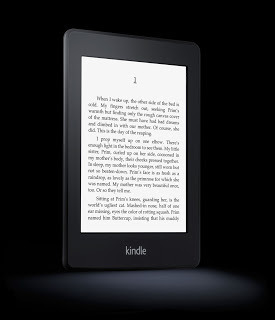 Like many readers and authors, I love everything about books, and was appalled at the prospect of trading elegant dust jackets and yellowing pages for hyperlinks and standard-issue Caecilia. My views began to change, however, as I watched my wife effortlessly breezing through books on her Kindle at a pace she’d never kept previously, while I clung to my ageing tomes, agonising over turning each page for fear of creasing their brittle spines. She could pick a buy a book, instantly download it, and finish it by the time that the one I’d ordered at the same time had arrived in the post. When we went on holiday her baggage allowance was used on clothes; half of mine went on pulp fiction paperbacks.
Like many readers and authors, I love everything about books, and was appalled at the prospect of trading elegant dust jackets and yellowing pages for hyperlinks and standard-issue Caecilia. My views began to change, however, as I watched my wife effortlessly breezing through books on her Kindle at a pace she’d never kept previously, while I clung to my ageing tomes, agonising over turning each page for fear of creasing their brittle spines. She could pick a buy a book, instantly download it, and finish it by the time that the one I’d ordered at the same time had arrived in the post. When we went on holiday her baggage allowance was used on clothes; half of mine went on pulp fiction paperbacks.
Even once I’d surrendered to the ease of e-books, I was still put off by the apparently limited availability of content. As a Doctor Who fan, for instance, I owned literally hundreds of titles dating back to the early 1990s, none of which I could replace digitally (unless you count with a few freebie PDFs downloaded from the BBCi website, none of which can be easily read on an e-reader). Fortunately times have changed enough to quash my fears in this regard - I now find that most new books that I want to read have a Kindle edition, and Amazon have even begun to sell electronic editions of long-since deleted Doctor Who titles (I even found The Infinity Doctors on there). And so, with much reluctance, earlier this year I sold off my sprawling collection of literary hardware and set about purchasing replacement electronic editions. Thanks to Amazon’s cloud, I can access any of my books anywhere that has an internet connection. I can turn pages by pressing a button, saving the wear on my increasingly-arthritic thumbs. I can enjoy reading a book again, instead of constantly fretting about how I could shoehorn yet another bookshelf into my rapidly-filling square footage.
Conversely, thanks in no small part to my older brother’s preoccupation with cutting-edge media technology, I’d been enjoying the benefits of a home theatre personal computer (“HTPC”) long before the advent of Apple TV and its coaster-sized rivals. It’s taken a number of years, though, for me to reach the stage where I’m truly happy with my audio / video setup, and along the way I’ve explored all manner of different media centre platforms. Needless to say, for most punters, Sky and its many off-the-peg accoutrements will be more than equal to their family’s entertainment needs (and probably their disposable income too…), but for those like me whose loathing of money-spinning subscriptions is outstripped only by their desire to retain and obsessively organise their music and videos, there are countless services out there waiting to be explored, each with their own pros and cons.
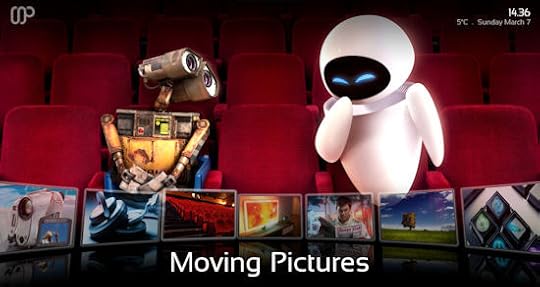 My first media centre setup was a custom-built, high-spec HTPC on which I ran MediaPortal. MediaPortal is free, open-source software that can turn the right PC into an all-singing, all-dancing high-definition (“HD”) media jukebox through which you can play your music; view your photo albums; watch and record live TV; and watch your videos. If your machine is equipped with a TV card, this software allows you to watch and record television, just as you would with a Sky+ or Freeview+ box, only with the added advantage of being able to retain that recording, should you be minded to, by cutting and pasting a recorded programme’s video file into one of your “My TV Series” or “My Movies” folders. You can add media to your library in other ways too, such as by using a program like MakeMKV to losslessly rip your existing DVD / blu-ray collection (though the lawyer in me feels compelled to point out that if the material is copyrighted, this is illegal, not that this bothers iTunes when it encourages you to rip any CD that you might insert whilst it’s running) or importing any files that you have (again, I presume, legally) downloaded that aren’t riddled with digital rights management (“DRM”). MediaPortal’s free downloadable “My TV Series” and “My Moving Pictures” (easily renamed to “My Movies”) plugins will automatically scan your folders for new videos at an interval that you decide, and, upon finding new files – providing they’ve been named in one of the recognised “ugly” styles (such as “The.Big.Bang.Theory.S06E10.The.Fish.Guts.Displacement” for TV series, or “The Dark Knight Rises (2012)” for movies) - retrieve the appropriate artwork and synopses for each of them from the internet, allowing you to instantly browse a stunning video library without having to reach for an unwieldy box set or its booklet.
My first media centre setup was a custom-built, high-spec HTPC on which I ran MediaPortal. MediaPortal is free, open-source software that can turn the right PC into an all-singing, all-dancing high-definition (“HD”) media jukebox through which you can play your music; view your photo albums; watch and record live TV; and watch your videos. If your machine is equipped with a TV card, this software allows you to watch and record television, just as you would with a Sky+ or Freeview+ box, only with the added advantage of being able to retain that recording, should you be minded to, by cutting and pasting a recorded programme’s video file into one of your “My TV Series” or “My Movies” folders. You can add media to your library in other ways too, such as by using a program like MakeMKV to losslessly rip your existing DVD / blu-ray collection (though the lawyer in me feels compelled to point out that if the material is copyrighted, this is illegal, not that this bothers iTunes when it encourages you to rip any CD that you might insert whilst it’s running) or importing any files that you have (again, I presume, legally) downloaded that aren’t riddled with digital rights management (“DRM”). MediaPortal’s free downloadable “My TV Series” and “My Moving Pictures” (easily renamed to “My Movies”) plugins will automatically scan your folders for new videos at an interval that you decide, and, upon finding new files – providing they’ve been named in one of the recognised “ugly” styles (such as “The.Big.Bang.Theory.S06E10.The.Fish.Guts.Displacement” for TV series, or “The Dark Knight Rises (2012)” for movies) - retrieve the appropriate artwork and synopses for each of them from the internet, allowing you to instantly browse a stunning video library without having to reach for an unwieldy box set or its booklet.
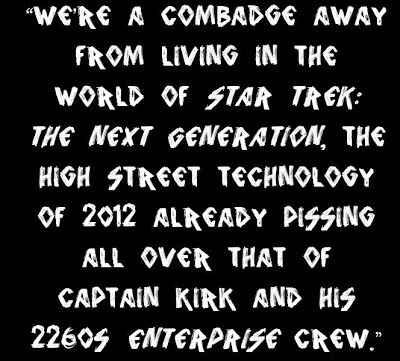 Perhaps the most appealing aspect of MediaPortal, though, is the extent to which it can be customised. Not only does it boast a wide variety of “skins” (free, downloadable user interfaces), many of which look nothing short of spectacular, but some of its plugins allow the user to amend movie synopses and posters with relative ease. Unfortunately this is not true of its “My TV Series” plugin (or at least it wasn’t the last time that I used the software), which draws its data and artwork from the open-source website TheTVDB.com. This was a constant source of frustration to me, particularly as some synopses found on there contain mistakes ranging from typographical to factually erroneous that have been “locked” by site administrators and therefore can’t be amended. If you’re technically minded enough, there are ways to get around this issue by amending the metadata on your local machine, but I found them disproportionately time-consuming. Similarly frustrating was the software’s inability to distinguish between music mp3 files, and audio book / audio drama mp3 files (of which I own many). I doubt that such things would bother most users, to be honest, but to someone as sophistic as me, these were very nearly deal-breakers.
Perhaps the most appealing aspect of MediaPortal, though, is the extent to which it can be customised. Not only does it boast a wide variety of “skins” (free, downloadable user interfaces), many of which look nothing short of spectacular, but some of its plugins allow the user to amend movie synopses and posters with relative ease. Unfortunately this is not true of its “My TV Series” plugin (or at least it wasn’t the last time that I used the software), which draws its data and artwork from the open-source website TheTVDB.com. This was a constant source of frustration to me, particularly as some synopses found on there contain mistakes ranging from typographical to factually erroneous that have been “locked” by site administrators and therefore can’t be amended. If you’re technically minded enough, there are ways to get around this issue by amending the metadata on your local machine, but I found them disproportionately time-consuming. Similarly frustrating was the software’s inability to distinguish between music mp3 files, and audio book / audio drama mp3 files (of which I own many). I doubt that such things would bother most users, to be honest, but to someone as sophistic as me, these were very nearly deal-breakers.
What would deter more users though is MediaPortal’s needlessly complex codec settings. As digital video is encoded in many different ways, different “codecs” are required to decode different types of video files. The trouble is, with MediaPortal, stumbling upon the optimum codec settings for your particular machine can be a long and painful process, and even once found, those settings can be adversely affected by other software’s automatic updates or a new software installation. To describe the system as “fragile” would be something of an understatement. Even with a couple of years’ worth of heavy usage under my system’s belt, there were still a few files that the software struggled with, dropping frames and losing lip-sync, and some that it wouldn’t play at all. To some users, being able to control which codecs are used to decode certain files will be what sets this software apart from the pack, but if you want something that will just work for you every time without having to toggle settings, then MediaPortal probably isn’t for you.
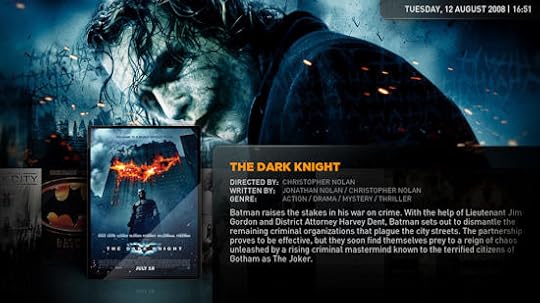 With this in mind, for a short while I tried running XBMC, MediaPortal’s better-known and longer-standing free open-source rival. To its credit, XBMC offered the same slick finish as MediaPortal, and played most file types that I threw at it – but not all. Unlike MediaPortal, which in a very circuitous way is capable of playing store-bought iTunes video (essentially you have to program it to launch iTunes as an external player whenever you want to play one of iTunes’ native DRM-protected m4v videos, and then close it and restore MediaPortal when it’s finished), I couldn’t get XMBC to do it, and worse still I had to turn off hardware acceleration to get it to render certain SD files properly, meaning that I’d have to remember to turn it back on to get it to play HD files. I’d simply traded one playback-related problem for another, and in doing so I’d lost the ability to watch and record TV, which at the time, XBMC didn’t support (with the release of v12 [“Frodo”], it does now). As with MediaPortal, I’m sure that any playback issues could be fixed with a little time and research, but these are precious commodities that many of us are short on.
With this in mind, for a short while I tried running XBMC, MediaPortal’s better-known and longer-standing free open-source rival. To its credit, XBMC offered the same slick finish as MediaPortal, and played most file types that I threw at it – but not all. Unlike MediaPortal, which in a very circuitous way is capable of playing store-bought iTunes video (essentially you have to program it to launch iTunes as an external player whenever you want to play one of iTunes’ native DRM-protected m4v videos, and then close it and restore MediaPortal when it’s finished), I couldn’t get XMBC to do it, and worse still I had to turn off hardware acceleration to get it to render certain SD files properly, meaning that I’d have to remember to turn it back on to get it to play HD files. I’d simply traded one playback-related problem for another, and in doing so I’d lost the ability to watch and record TV, which at the time, XBMC didn’t support (with the release of v12 [“Frodo”], it does now). As with MediaPortal, I’m sure that any playback issues could be fixed with a little time and research, but these are precious commodities that many of us are short on.
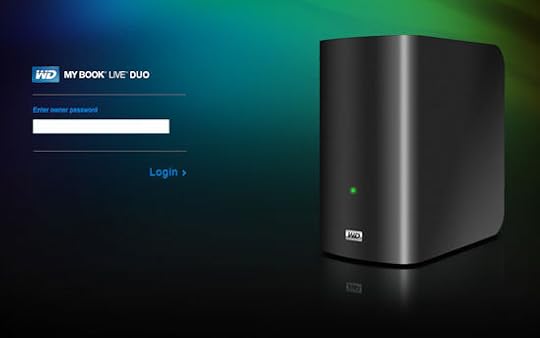
While experimenting with XBMC, I purchased my first media server – Western Digital’s My Book Live Duo. A jaw-droppingly compact device containing two 3TB hard drives, the My Book Live Duo plugs into your wireless router and streams the media on it to any DLNA-certified device in your home (without using up your download allowance from your internet service provider, I should add -streaming bypasses the web entirely). Whilst expensive, it’s a beautiful and reliable piece of kit that does exactly what it says on the tin, as well as offering you the peace of mind that comes with RAID mirroring (whatever it stores on one of its hard drives, it mirrors on the other, so if either goes kaput, your media is safe). It even allows you to connect additional storage devices to it via USB (though be warned, if you intend to connect more than one, as I have, you’ll need to purchase a hub as there’s only one USB port) so that their contents can be wirelessly streamed around your home too. As I was so happy with this product, I decided to try retiring my HTPC altogether and instead simply stream the media directly from the My Book Live Duo to a media player. My weapon of choice was, initially, Western Digital’s five-inch square WDTV Live.
WDTV Live is a great option if you don’t fancy having a poorly-disguised PC sat underneath your TV. Within moments of connecting it up, mine had found the My Book Live Duo on my home network and begun compiling its “Media Library” by indexing all the media files (the videos all bearing “ugly” file names) that it found upon it, and downloading the appropriate artwork and synopses in exactly the same way that XBMC and MediaPortal do. Unfortunately in my case this process took days, given the size of my library, and when it had finally finished, I found the interface poor when measured against XBMC and MediaPortal. There are no screengrabs for individual episodes of a TV series, for instance – every episode of eeach series is represented by the same - and often inappropriate - generic thumbnail, while its series or season folder (and it does present them as computer-style folders) has no image at all. Worse still, the WDTV Live’s native interface doesn’t differentiate between movies and TV series, let alone music and audio books, which for me is amongst the vilest of sins. Admittedly, if you’re prepared to flash your box’s firmware and/or install different skins, you can get around these issues, but for those of a “plug and play” mindset, the WDTV Live box is far from ideal in this respect.
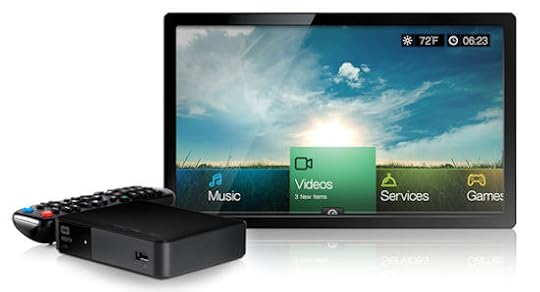
Where WDTV Live truly trounces all of its rivals though is in its playback. Given media centre software’s focus on alluring artwork and enticing write-ups, it’s easy to forget what a media player is all about – enjoying the media. There are no codecs to wrestle with here; no hardware acceleration to toggle. Provided that your router is up to it, this box will play just about anything without dropping a single frame, even 1080p/1080i 50GB movies, and do so faultlessly. Even with its interface issues, this would have been enough for this little device to cement itself as my household’s main media player, but unfortunately it didn’t take long for me to realise that its “will play anything” reputation wasn’t entirely deserved.
Firstly, it couldn’t cope with iTunes media, or indeed anything that utilises DRM. We truly live in a backward world when media that you legally buy is incompatible with just about every device on the market, whereas people who download it illegally can play it just about anywhere. I may be in the minority here, but I have no issue with paying for videos that I want to watch – but I do want to watch them, and sadly for Western Digital, their little box couldn’t hope to accommodate that. Worse still was WDTV Live’s apparent inability to effectively liaise with the same manufacturer’s My Book Live Duo. Whilst it instantly discovered the device’s built-in hard drives, I could not get it to detect the media on any of the external drives connected to it via USB despite trying several different hubs. It saw them all, but, according to it, they housed no media. As my HTPC could effortlessly stream content from them all using Media Portal; XBMC; and even Windows Media Player, this was plainly not the case. My post in Western Digital’s forum went unanswered for weeks. My frustration grew. The WDTV Live was eBayed. I had nowhere to turn but to the DRM-domineering Apple. Little did I know, I’d unwittingly saved the best until last.
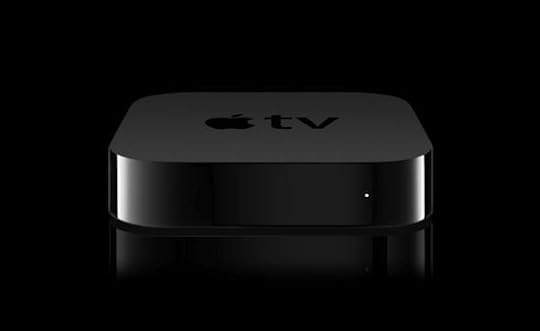 In the last couple of years, I’ve become addicted to Apple hardware. As my old friend Mark #II preaches to all who’ll listen, “Once you go Mac, you never go back”, and it’s true. My iPad’s never crashed; my iPhone is a technological marvel on which I can read books, listen to music, watch videos, do my banking and effectively run my whole life. Thanks to the genius of the My Book Live Duo, I can even access the content on my server from anywhere in the world that has an internet connection (though to date the farthest afield I’ve tested it is Rotherham). Despite this mounting ardour, though, I’ve always been wary of Apple TV – largely because I couldn’t face converting my old videos into Apple-proof mp4 or m4v. Having test-run the device with my iTunes-bought content though, I decided that it was clearly the worth the effort.
In the last couple of years, I’ve become addicted to Apple hardware. As my old friend Mark #II preaches to all who’ll listen, “Once you go Mac, you never go back”, and it’s true. My iPad’s never crashed; my iPhone is a technological marvel on which I can read books, listen to music, watch videos, do my banking and effectively run my whole life. Thanks to the genius of the My Book Live Duo, I can even access the content on my server from anywhere in the world that has an internet connection (though to date the farthest afield I’ve tested it is Rotherham). Despite this mounting ardour, though, I’ve always been wary of Apple TV – largely because I couldn’t face converting my old videos into Apple-proof mp4 or m4v. Having test-run the device with my iTunes-bought content though, I decided that it was clearly the worth the effort.
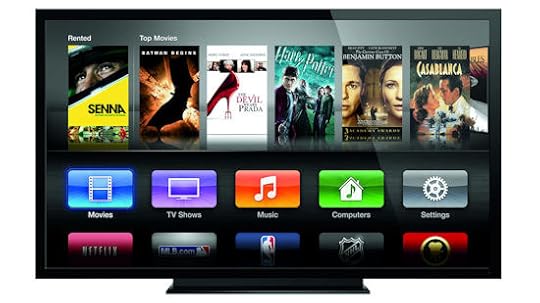
The strain of encoding might well kill off my long-suffering HTPC, but already I’m reaping the rewards. I can watch the videos that I buy straight away, be it on my phone, tablet or massive telly – on demand Peep Show, quick as flash, in glorious 1080i as opposed to soft old SD on DVD, long after transmission. My iTunes-bought content is even backed up for free in the cloud. I can amend movie and episode synopses – yes, the poorly-proofed iTunes Store is not much better than open-source websites - I can utilise custom artwork, find bonus material neatly married up with the main feature that it accompanies, make frighteningly sad playlists that allow me to enjoy a medley of Doctor Who audio books and TV episodes in what I think should be the correct order. I can dial up a programme on the BBC iPlayer, or ITV Player, and with a flick of the wrist have it playing through the TV via AirPlay. Ditto YouTube, or a photo or video that I’ve taken just seconds ago on my iPhone. Best of all though, it never, ever crashes and even the wife can work it – something that I can’t say about any of the platforms I’d tried previously. And for all this magic, all that I have to have sat in my toddler-terrorised living room is a tiny little box a few square inches in size.
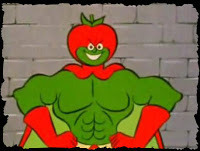 The trade-off? I’ve become a firm Apple man, which as my good friend (and passionate VHS backer) Daniel Tessier implied in a Facebook quip, paints me as something of a cartoon villain, squarely at odds with Bananaman. A quick-off-the-mark witticism, or a colourful metaphor for the old PC v Mac / everything else v Apple TV war? I wonder. Nevertheless, hero or villain, I’m finally winning…
The trade-off? I’ve become a firm Apple man, which as my good friend (and passionate VHS backer) Daniel Tessier implied in a Facebook quip, paints me as something of a cartoon villain, squarely at odds with Bananaman. A quick-off-the-mark witticism, or a colourful metaphor for the old PC v Mac / everything else v Apple TV war? I wonder. Nevertheless, hero or villain, I’m finally winning…
For UK readers not appalled by my shameless defection to the Apple camp, you might want to know that for some baffling reason, the high street chain Wilkinson is selling £25.00 iTunes vouchers for £20.00. Stock up!
 Like many readers and authors, I love everything about books, and was appalled at the prospect of trading elegant dust jackets and yellowing pages for hyperlinks and standard-issue Caecilia. My views began to change, however, as I watched my wife effortlessly breezing through books on her Kindle at a pace she’d never kept previously, while I clung to my ageing tomes, agonising over turning each page for fear of creasing their brittle spines. She could pick a buy a book, instantly download it, and finish it by the time that the one I’d ordered at the same time had arrived in the post. When we went on holiday her baggage allowance was used on clothes; half of mine went on pulp fiction paperbacks.
Like many readers and authors, I love everything about books, and was appalled at the prospect of trading elegant dust jackets and yellowing pages for hyperlinks and standard-issue Caecilia. My views began to change, however, as I watched my wife effortlessly breezing through books on her Kindle at a pace she’d never kept previously, while I clung to my ageing tomes, agonising over turning each page for fear of creasing their brittle spines. She could pick a buy a book, instantly download it, and finish it by the time that the one I’d ordered at the same time had arrived in the post. When we went on holiday her baggage allowance was used on clothes; half of mine went on pulp fiction paperbacks. Even once I’d surrendered to the ease of e-books, I was still put off by the apparently limited availability of content. As a Doctor Who fan, for instance, I owned literally hundreds of titles dating back to the early 1990s, none of which I could replace digitally (unless you count with a few freebie PDFs downloaded from the BBCi website, none of which can be easily read on an e-reader). Fortunately times have changed enough to quash my fears in this regard - I now find that most new books that I want to read have a Kindle edition, and Amazon have even begun to sell electronic editions of long-since deleted Doctor Who titles (I even found The Infinity Doctors on there). And so, with much reluctance, earlier this year I sold off my sprawling collection of literary hardware and set about purchasing replacement electronic editions. Thanks to Amazon’s cloud, I can access any of my books anywhere that has an internet connection. I can turn pages by pressing a button, saving the wear on my increasingly-arthritic thumbs. I can enjoy reading a book again, instead of constantly fretting about how I could shoehorn yet another bookshelf into my rapidly-filling square footage.
Conversely, thanks in no small part to my older brother’s preoccupation with cutting-edge media technology, I’d been enjoying the benefits of a home theatre personal computer (“HTPC”) long before the advent of Apple TV and its coaster-sized rivals. It’s taken a number of years, though, for me to reach the stage where I’m truly happy with my audio / video setup, and along the way I’ve explored all manner of different media centre platforms. Needless to say, for most punters, Sky and its many off-the-peg accoutrements will be more than equal to their family’s entertainment needs (and probably their disposable income too…), but for those like me whose loathing of money-spinning subscriptions is outstripped only by their desire to retain and obsessively organise their music and videos, there are countless services out there waiting to be explored, each with their own pros and cons.
 My first media centre setup was a custom-built, high-spec HTPC on which I ran MediaPortal. MediaPortal is free, open-source software that can turn the right PC into an all-singing, all-dancing high-definition (“HD”) media jukebox through which you can play your music; view your photo albums; watch and record live TV; and watch your videos. If your machine is equipped with a TV card, this software allows you to watch and record television, just as you would with a Sky+ or Freeview+ box, only with the added advantage of being able to retain that recording, should you be minded to, by cutting and pasting a recorded programme’s video file into one of your “My TV Series” or “My Movies” folders. You can add media to your library in other ways too, such as by using a program like MakeMKV to losslessly rip your existing DVD / blu-ray collection (though the lawyer in me feels compelled to point out that if the material is copyrighted, this is illegal, not that this bothers iTunes when it encourages you to rip any CD that you might insert whilst it’s running) or importing any files that you have (again, I presume, legally) downloaded that aren’t riddled with digital rights management (“DRM”). MediaPortal’s free downloadable “My TV Series” and “My Moving Pictures” (easily renamed to “My Movies”) plugins will automatically scan your folders for new videos at an interval that you decide, and, upon finding new files – providing they’ve been named in one of the recognised “ugly” styles (such as “The.Big.Bang.Theory.S06E10.The.Fish.Guts.Displacement” for TV series, or “The Dark Knight Rises (2012)” for movies) - retrieve the appropriate artwork and synopses for each of them from the internet, allowing you to instantly browse a stunning video library without having to reach for an unwieldy box set or its booklet.
My first media centre setup was a custom-built, high-spec HTPC on which I ran MediaPortal. MediaPortal is free, open-source software that can turn the right PC into an all-singing, all-dancing high-definition (“HD”) media jukebox through which you can play your music; view your photo albums; watch and record live TV; and watch your videos. If your machine is equipped with a TV card, this software allows you to watch and record television, just as you would with a Sky+ or Freeview+ box, only with the added advantage of being able to retain that recording, should you be minded to, by cutting and pasting a recorded programme’s video file into one of your “My TV Series” or “My Movies” folders. You can add media to your library in other ways too, such as by using a program like MakeMKV to losslessly rip your existing DVD / blu-ray collection (though the lawyer in me feels compelled to point out that if the material is copyrighted, this is illegal, not that this bothers iTunes when it encourages you to rip any CD that you might insert whilst it’s running) or importing any files that you have (again, I presume, legally) downloaded that aren’t riddled with digital rights management (“DRM”). MediaPortal’s free downloadable “My TV Series” and “My Moving Pictures” (easily renamed to “My Movies”) plugins will automatically scan your folders for new videos at an interval that you decide, and, upon finding new files – providing they’ve been named in one of the recognised “ugly” styles (such as “The.Big.Bang.Theory.S06E10.The.Fish.Guts.Displacement” for TV series, or “The Dark Knight Rises (2012)” for movies) - retrieve the appropriate artwork and synopses for each of them from the internet, allowing you to instantly browse a stunning video library without having to reach for an unwieldy box set or its booklet.  Perhaps the most appealing aspect of MediaPortal, though, is the extent to which it can be customised. Not only does it boast a wide variety of “skins” (free, downloadable user interfaces), many of which look nothing short of spectacular, but some of its plugins allow the user to amend movie synopses and posters with relative ease. Unfortunately this is not true of its “My TV Series” plugin (or at least it wasn’t the last time that I used the software), which draws its data and artwork from the open-source website TheTVDB.com. This was a constant source of frustration to me, particularly as some synopses found on there contain mistakes ranging from typographical to factually erroneous that have been “locked” by site administrators and therefore can’t be amended. If you’re technically minded enough, there are ways to get around this issue by amending the metadata on your local machine, but I found them disproportionately time-consuming. Similarly frustrating was the software’s inability to distinguish between music mp3 files, and audio book / audio drama mp3 files (of which I own many). I doubt that such things would bother most users, to be honest, but to someone as sophistic as me, these were very nearly deal-breakers.
Perhaps the most appealing aspect of MediaPortal, though, is the extent to which it can be customised. Not only does it boast a wide variety of “skins” (free, downloadable user interfaces), many of which look nothing short of spectacular, but some of its plugins allow the user to amend movie synopses and posters with relative ease. Unfortunately this is not true of its “My TV Series” plugin (or at least it wasn’t the last time that I used the software), which draws its data and artwork from the open-source website TheTVDB.com. This was a constant source of frustration to me, particularly as some synopses found on there contain mistakes ranging from typographical to factually erroneous that have been “locked” by site administrators and therefore can’t be amended. If you’re technically minded enough, there are ways to get around this issue by amending the metadata on your local machine, but I found them disproportionately time-consuming. Similarly frustrating was the software’s inability to distinguish between music mp3 files, and audio book / audio drama mp3 files (of which I own many). I doubt that such things would bother most users, to be honest, but to someone as sophistic as me, these were very nearly deal-breakers.What would deter more users though is MediaPortal’s needlessly complex codec settings. As digital video is encoded in many different ways, different “codecs” are required to decode different types of video files. The trouble is, with MediaPortal, stumbling upon the optimum codec settings for your particular machine can be a long and painful process, and even once found, those settings can be adversely affected by other software’s automatic updates or a new software installation. To describe the system as “fragile” would be something of an understatement. Even with a couple of years’ worth of heavy usage under my system’s belt, there were still a few files that the software struggled with, dropping frames and losing lip-sync, and some that it wouldn’t play at all. To some users, being able to control which codecs are used to decode certain files will be what sets this software apart from the pack, but if you want something that will just work for you every time without having to toggle settings, then MediaPortal probably isn’t for you.
 With this in mind, for a short while I tried running XBMC, MediaPortal’s better-known and longer-standing free open-source rival. To its credit, XBMC offered the same slick finish as MediaPortal, and played most file types that I threw at it – but not all. Unlike MediaPortal, which in a very circuitous way is capable of playing store-bought iTunes video (essentially you have to program it to launch iTunes as an external player whenever you want to play one of iTunes’ native DRM-protected m4v videos, and then close it and restore MediaPortal when it’s finished), I couldn’t get XMBC to do it, and worse still I had to turn off hardware acceleration to get it to render certain SD files properly, meaning that I’d have to remember to turn it back on to get it to play HD files. I’d simply traded one playback-related problem for another, and in doing so I’d lost the ability to watch and record TV, which at the time, XBMC didn’t support (with the release of v12 [“Frodo”], it does now). As with MediaPortal, I’m sure that any playback issues could be fixed with a little time and research, but these are precious commodities that many of us are short on.
With this in mind, for a short while I tried running XBMC, MediaPortal’s better-known and longer-standing free open-source rival. To its credit, XBMC offered the same slick finish as MediaPortal, and played most file types that I threw at it – but not all. Unlike MediaPortal, which in a very circuitous way is capable of playing store-bought iTunes video (essentially you have to program it to launch iTunes as an external player whenever you want to play one of iTunes’ native DRM-protected m4v videos, and then close it and restore MediaPortal when it’s finished), I couldn’t get XMBC to do it, and worse still I had to turn off hardware acceleration to get it to render certain SD files properly, meaning that I’d have to remember to turn it back on to get it to play HD files. I’d simply traded one playback-related problem for another, and in doing so I’d lost the ability to watch and record TV, which at the time, XBMC didn’t support (with the release of v12 [“Frodo”], it does now). As with MediaPortal, I’m sure that any playback issues could be fixed with a little time and research, but these are precious commodities that many of us are short on.
While experimenting with XBMC, I purchased my first media server – Western Digital’s My Book Live Duo. A jaw-droppingly compact device containing two 3TB hard drives, the My Book Live Duo plugs into your wireless router and streams the media on it to any DLNA-certified device in your home (without using up your download allowance from your internet service provider, I should add -streaming bypasses the web entirely). Whilst expensive, it’s a beautiful and reliable piece of kit that does exactly what it says on the tin, as well as offering you the peace of mind that comes with RAID mirroring (whatever it stores on one of its hard drives, it mirrors on the other, so if either goes kaput, your media is safe). It even allows you to connect additional storage devices to it via USB (though be warned, if you intend to connect more than one, as I have, you’ll need to purchase a hub as there’s only one USB port) so that their contents can be wirelessly streamed around your home too. As I was so happy with this product, I decided to try retiring my HTPC altogether and instead simply stream the media directly from the My Book Live Duo to a media player. My weapon of choice was, initially, Western Digital’s five-inch square WDTV Live.
WDTV Live is a great option if you don’t fancy having a poorly-disguised PC sat underneath your TV. Within moments of connecting it up, mine had found the My Book Live Duo on my home network and begun compiling its “Media Library” by indexing all the media files (the videos all bearing “ugly” file names) that it found upon it, and downloading the appropriate artwork and synopses in exactly the same way that XBMC and MediaPortal do. Unfortunately in my case this process took days, given the size of my library, and when it had finally finished, I found the interface poor when measured against XBMC and MediaPortal. There are no screengrabs for individual episodes of a TV series, for instance – every episode of eeach series is represented by the same - and often inappropriate - generic thumbnail, while its series or season folder (and it does present them as computer-style folders) has no image at all. Worse still, the WDTV Live’s native interface doesn’t differentiate between movies and TV series, let alone music and audio books, which for me is amongst the vilest of sins. Admittedly, if you’re prepared to flash your box’s firmware and/or install different skins, you can get around these issues, but for those of a “plug and play” mindset, the WDTV Live box is far from ideal in this respect.

Where WDTV Live truly trounces all of its rivals though is in its playback. Given media centre software’s focus on alluring artwork and enticing write-ups, it’s easy to forget what a media player is all about – enjoying the media. There are no codecs to wrestle with here; no hardware acceleration to toggle. Provided that your router is up to it, this box will play just about anything without dropping a single frame, even 1080p/1080i 50GB movies, and do so faultlessly. Even with its interface issues, this would have been enough for this little device to cement itself as my household’s main media player, but unfortunately it didn’t take long for me to realise that its “will play anything” reputation wasn’t entirely deserved.
Firstly, it couldn’t cope with iTunes media, or indeed anything that utilises DRM. We truly live in a backward world when media that you legally buy is incompatible with just about every device on the market, whereas people who download it illegally can play it just about anywhere. I may be in the minority here, but I have no issue with paying for videos that I want to watch – but I do want to watch them, and sadly for Western Digital, their little box couldn’t hope to accommodate that. Worse still was WDTV Live’s apparent inability to effectively liaise with the same manufacturer’s My Book Live Duo. Whilst it instantly discovered the device’s built-in hard drives, I could not get it to detect the media on any of the external drives connected to it via USB despite trying several different hubs. It saw them all, but, according to it, they housed no media. As my HTPC could effortlessly stream content from them all using Media Portal; XBMC; and even Windows Media Player, this was plainly not the case. My post in Western Digital’s forum went unanswered for weeks. My frustration grew. The WDTV Live was eBayed. I had nowhere to turn but to the DRM-domineering Apple. Little did I know, I’d unwittingly saved the best until last.
 In the last couple of years, I’ve become addicted to Apple hardware. As my old friend Mark #II preaches to all who’ll listen, “Once you go Mac, you never go back”, and it’s true. My iPad’s never crashed; my iPhone is a technological marvel on which I can read books, listen to music, watch videos, do my banking and effectively run my whole life. Thanks to the genius of the My Book Live Duo, I can even access the content on my server from anywhere in the world that has an internet connection (though to date the farthest afield I’ve tested it is Rotherham). Despite this mounting ardour, though, I’ve always been wary of Apple TV – largely because I couldn’t face converting my old videos into Apple-proof mp4 or m4v. Having test-run the device with my iTunes-bought content though, I decided that it was clearly the worth the effort.
In the last couple of years, I’ve become addicted to Apple hardware. As my old friend Mark #II preaches to all who’ll listen, “Once you go Mac, you never go back”, and it’s true. My iPad’s never crashed; my iPhone is a technological marvel on which I can read books, listen to music, watch videos, do my banking and effectively run my whole life. Thanks to the genius of the My Book Live Duo, I can even access the content on my server from anywhere in the world that has an internet connection (though to date the farthest afield I’ve tested it is Rotherham). Despite this mounting ardour, though, I’ve always been wary of Apple TV – largely because I couldn’t face converting my old videos into Apple-proof mp4 or m4v. Having test-run the device with my iTunes-bought content though, I decided that it was clearly the worth the effort.
The strain of encoding might well kill off my long-suffering HTPC, but already I’m reaping the rewards. I can watch the videos that I buy straight away, be it on my phone, tablet or massive telly – on demand Peep Show, quick as flash, in glorious 1080i as opposed to soft old SD on DVD, long after transmission. My iTunes-bought content is even backed up for free in the cloud. I can amend movie and episode synopses – yes, the poorly-proofed iTunes Store is not much better than open-source websites - I can utilise custom artwork, find bonus material neatly married up with the main feature that it accompanies, make frighteningly sad playlists that allow me to enjoy a medley of Doctor Who audio books and TV episodes in what I think should be the correct order. I can dial up a programme on the BBC iPlayer, or ITV Player, and with a flick of the wrist have it playing through the TV via AirPlay. Ditto YouTube, or a photo or video that I’ve taken just seconds ago on my iPhone. Best of all though, it never, ever crashes and even the wife can work it – something that I can’t say about any of the platforms I’d tried previously. And for all this magic, all that I have to have sat in my toddler-terrorised living room is a tiny little box a few square inches in size.
 The trade-off? I’ve become a firm Apple man, which as my good friend (and passionate VHS backer) Daniel Tessier implied in a Facebook quip, paints me as something of a cartoon villain, squarely at odds with Bananaman. A quick-off-the-mark witticism, or a colourful metaphor for the old PC v Mac / everything else v Apple TV war? I wonder. Nevertheless, hero or villain, I’m finally winning…
The trade-off? I’ve become a firm Apple man, which as my good friend (and passionate VHS backer) Daniel Tessier implied in a Facebook quip, paints me as something of a cartoon villain, squarely at odds with Bananaman. A quick-off-the-mark witticism, or a colourful metaphor for the old PC v Mac / everything else v Apple TV war? I wonder. Nevertheless, hero or villain, I’m finally winning…For UK readers not appalled by my shameless defection to the Apple camp, you might want to know that for some baffling reason, the high street chain Wilkinson is selling £25.00 iTunes vouchers for £20.00. Stock up!
Published on December 20, 2012 01:40
November 29, 2012
Blu-ray Review | American Reunion (aka American Pie: Reunion) (Unrated Edition)
American Pie’s scintillating synthesis of scatological humour and brazen nudity made it an instant hit with my late-teen self back in the summer of ’99, its comic teenage lust offering me an hour and a half’s reprieve from my own libido-fuelled woes. Two years later, its slightly-more-syrupy sequel’s parting of ways mirrored my own leaving for university (though admittedly my departing misadventures were marked by fewer scantily-clad lesbians and… uh… creative musicians, more’s the pity). Fast-forward to the fag end of my uni days, and Jim and Michelle’s American Wedding (or American Pie: The Wedding to us slow-on-the-uptake Brits) was followed in short order by my own engagement, drawing a heavy line under both Jim and company’s licentious capers, and my own. Or so I’d thought.
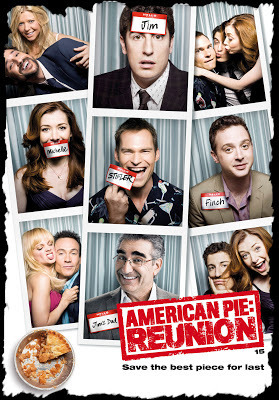 As I enter my second year of parenthood, American Reunion arrives on blu-ray to look for hilarity and absurdity in every aspect of life’s latest chapter, while at the same time gently emphasising what and whom life is all about. The thumping of Jim and Michelle’s bed as the movie opens sets the stall for the cruel commentary that’s to come, as the camera pans up to reveal the apparently ageless Jason Biggs’ Jim “working” on his laptop, while his once-inventive musical missus (How I Met Your Mother and erstwhile Buffy star Alyson Hannigan) rigorously bounces their baby boy to sleep. With similar succinctness the film swiftly summarises the sexless plight of the pubescent pactees that we met over a decade ago, each (to coin a favourite phrase of my mother’s) having become more like themselves as they’ve grown older. Chris Klein’s Ostreicher has sold his soul for celebrity - former sweetheart Heather (Mena Suvari of American Beauty fame) no longer hangs from his arm; instead, he’s involved with a vacuous model who’s more besotted with his money and status than she is him. Seann William Scott’s Stifler has, quite predictably, failed to mature even by the slightest degree, but now his alpha male delusions of dominance are frequently shattered by his pocket-sized boss, who is keen to remind him that he’s the “bitch”. Just as true to form, Eddie Kaye Thomas’s Paul Finch has carefully constructed the veneer of a motorbike-riding, African tribe-leading, enigmatic world-wanderer, but beneath his studied façade hides a fraud who wouldn’t be out of place working at Dunder Mifflin’s Office on NBC. Kevin (Thomas Ian Nicholas), meanwhile, has got married and grown an ill-advised beard, but remains as overemotional and hastily condemnatory as the exasperating youth whose sexual fears gave rise to first movie’s “let’s all get laid together” maguffin. As I caught up with these lives, I found myself reflecting on my own and those of my ever-dwindling clique, and how uncannily they’ve mirrored those of our larger-than-life American peers - the blandness; the failures; the ridiculous facial hair; even the occasional, whiff-of-a-pint yearning for times past.
As I enter my second year of parenthood, American Reunion arrives on blu-ray to look for hilarity and absurdity in every aspect of life’s latest chapter, while at the same time gently emphasising what and whom life is all about. The thumping of Jim and Michelle’s bed as the movie opens sets the stall for the cruel commentary that’s to come, as the camera pans up to reveal the apparently ageless Jason Biggs’ Jim “working” on his laptop, while his once-inventive musical missus (How I Met Your Mother and erstwhile Buffy star Alyson Hannigan) rigorously bounces their baby boy to sleep. With similar succinctness the film swiftly summarises the sexless plight of the pubescent pactees that we met over a decade ago, each (to coin a favourite phrase of my mother’s) having become more like themselves as they’ve grown older. Chris Klein’s Ostreicher has sold his soul for celebrity - former sweetheart Heather (Mena Suvari of American Beauty fame) no longer hangs from his arm; instead, he’s involved with a vacuous model who’s more besotted with his money and status than she is him. Seann William Scott’s Stifler has, quite predictably, failed to mature even by the slightest degree, but now his alpha male delusions of dominance are frequently shattered by his pocket-sized boss, who is keen to remind him that he’s the “bitch”. Just as true to form, Eddie Kaye Thomas’s Paul Finch has carefully constructed the veneer of a motorbike-riding, African tribe-leading, enigmatic world-wanderer, but beneath his studied façade hides a fraud who wouldn’t be out of place working at Dunder Mifflin’s Office on NBC. Kevin (Thomas Ian Nicholas), meanwhile, has got married and grown an ill-advised beard, but remains as overemotional and hastily condemnatory as the exasperating youth whose sexual fears gave rise to first movie’s “let’s all get laid together” maguffin. As I caught up with these lives, I found myself reflecting on my own and those of my ever-dwindling clique, and how uncannily they’ve mirrored those of our larger-than-life American peers - the blandness; the failures; the ridiculous facial hair; even the occasional, whiff-of-a-pint yearning for times past.

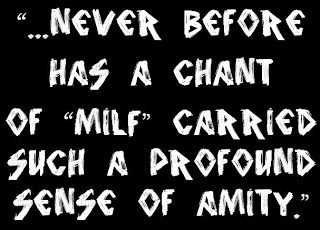 Indeed, many aspects of American Reunion put me in mind of the countless jolly boys’ outings that I’ve enjoyed in recent years with my Hull University alumni. Whilst duly riotous, each “lads’ weekend” is tainted by a crippling sense of morbid nostalgia, perhaps even loss, that this movie captures beautifully. Its Carry On-style comedy is expectedly low-brow and slapstick, but it’s frequently underlined by excruciating melancholy. The uproarious drunken revelry of Eugene Levy’s Noah Levenstein (now a veteran of eight American Pies, if we include the rubbish straight-to-DVD spin-off ones) is ultimately borne of a widower’s lonesomeness; Finch’s crimes were precipitated by the mortification that he feels at not having lived up to his intellectual potential. Even the luscious merriment of the film’s fitting “Finch’s mom” dénouement is counterpointed by the surprisingly-stirring reconciliation of the long-since estranged ‘“MILF” guys’ - never before has a chant of “MILF” carried such a profound sense of amity.
Indeed, many aspects of American Reunion put me in mind of the countless jolly boys’ outings that I’ve enjoyed in recent years with my Hull University alumni. Whilst duly riotous, each “lads’ weekend” is tainted by a crippling sense of morbid nostalgia, perhaps even loss, that this movie captures beautifully. Its Carry On-style comedy is expectedly low-brow and slapstick, but it’s frequently underlined by excruciating melancholy. The uproarious drunken revelry of Eugene Levy’s Noah Levenstein (now a veteran of eight American Pies, if we include the rubbish straight-to-DVD spin-off ones) is ultimately borne of a widower’s lonesomeness; Finch’s crimes were precipitated by the mortification that he feels at not having lived up to his intellectual potential. Even the luscious merriment of the film’s fitting “Finch’s mom” dénouement is counterpointed by the surprisingly-stirring reconciliation of the long-since estranged ‘“MILF” guys’ - never before has a chant of “MILF” carried such a profound sense of amity.

As I watched this franchise’s first movie play out before me on the silver screen, I never dreamed that its characters would be joining me on a lifelong journey involving love, loss and shitting in beer crates, but that’s exactly what’s transpired. If you’re in the mood for some high-end trash that boasts a few proudly-gratuitous pairs of tits (the exquisite Ali Cobrin’s amongst them, above); a knob shrouded in see-through kitchenware; some cheap laughs; and some saccharine sentiments, then do yourself a favour and get yourself to the Reunion. Having endured it and enjoyed it, I’m looking forward to catching up with this lot again in a couple of decades’ time for American Menopause (or American Pie: The Menopause for us obdurate Pie-munchers in the UK).
 As I enter my second year of parenthood, American Reunion arrives on blu-ray to look for hilarity and absurdity in every aspect of life’s latest chapter, while at the same time gently emphasising what and whom life is all about. The thumping of Jim and Michelle’s bed as the movie opens sets the stall for the cruel commentary that’s to come, as the camera pans up to reveal the apparently ageless Jason Biggs’ Jim “working” on his laptop, while his once-inventive musical missus (How I Met Your Mother and erstwhile Buffy star Alyson Hannigan) rigorously bounces their baby boy to sleep. With similar succinctness the film swiftly summarises the sexless plight of the pubescent pactees that we met over a decade ago, each (to coin a favourite phrase of my mother’s) having become more like themselves as they’ve grown older. Chris Klein’s Ostreicher has sold his soul for celebrity - former sweetheart Heather (Mena Suvari of American Beauty fame) no longer hangs from his arm; instead, he’s involved with a vacuous model who’s more besotted with his money and status than she is him. Seann William Scott’s Stifler has, quite predictably, failed to mature even by the slightest degree, but now his alpha male delusions of dominance are frequently shattered by his pocket-sized boss, who is keen to remind him that he’s the “bitch”. Just as true to form, Eddie Kaye Thomas’s Paul Finch has carefully constructed the veneer of a motorbike-riding, African tribe-leading, enigmatic world-wanderer, but beneath his studied façade hides a fraud who wouldn’t be out of place working at Dunder Mifflin’s Office on NBC. Kevin (Thomas Ian Nicholas), meanwhile, has got married and grown an ill-advised beard, but remains as overemotional and hastily condemnatory as the exasperating youth whose sexual fears gave rise to first movie’s “let’s all get laid together” maguffin. As I caught up with these lives, I found myself reflecting on my own and those of my ever-dwindling clique, and how uncannily they’ve mirrored those of our larger-than-life American peers - the blandness; the failures; the ridiculous facial hair; even the occasional, whiff-of-a-pint yearning for times past.
As I enter my second year of parenthood, American Reunion arrives on blu-ray to look for hilarity and absurdity in every aspect of life’s latest chapter, while at the same time gently emphasising what and whom life is all about. The thumping of Jim and Michelle’s bed as the movie opens sets the stall for the cruel commentary that’s to come, as the camera pans up to reveal the apparently ageless Jason Biggs’ Jim “working” on his laptop, while his once-inventive musical missus (How I Met Your Mother and erstwhile Buffy star Alyson Hannigan) rigorously bounces their baby boy to sleep. With similar succinctness the film swiftly summarises the sexless plight of the pubescent pactees that we met over a decade ago, each (to coin a favourite phrase of my mother’s) having become more like themselves as they’ve grown older. Chris Klein’s Ostreicher has sold his soul for celebrity - former sweetheart Heather (Mena Suvari of American Beauty fame) no longer hangs from his arm; instead, he’s involved with a vacuous model who’s more besotted with his money and status than she is him. Seann William Scott’s Stifler has, quite predictably, failed to mature even by the slightest degree, but now his alpha male delusions of dominance are frequently shattered by his pocket-sized boss, who is keen to remind him that he’s the “bitch”. Just as true to form, Eddie Kaye Thomas’s Paul Finch has carefully constructed the veneer of a motorbike-riding, African tribe-leading, enigmatic world-wanderer, but beneath his studied façade hides a fraud who wouldn’t be out of place working at Dunder Mifflin’s Office on NBC. Kevin (Thomas Ian Nicholas), meanwhile, has got married and grown an ill-advised beard, but remains as overemotional and hastily condemnatory as the exasperating youth whose sexual fears gave rise to first movie’s “let’s all get laid together” maguffin. As I caught up with these lives, I found myself reflecting on my own and those of my ever-dwindling clique, and how uncannily they’ve mirrored those of our larger-than-life American peers - the blandness; the failures; the ridiculous facial hair; even the occasional, whiff-of-a-pint yearning for times past.
 Indeed, many aspects of American Reunion put me in mind of the countless jolly boys’ outings that I’ve enjoyed in recent years with my Hull University alumni. Whilst duly riotous, each “lads’ weekend” is tainted by a crippling sense of morbid nostalgia, perhaps even loss, that this movie captures beautifully. Its Carry On-style comedy is expectedly low-brow and slapstick, but it’s frequently underlined by excruciating melancholy. The uproarious drunken revelry of Eugene Levy’s Noah Levenstein (now a veteran of eight American Pies, if we include the rubbish straight-to-DVD spin-off ones) is ultimately borne of a widower’s lonesomeness; Finch’s crimes were precipitated by the mortification that he feels at not having lived up to his intellectual potential. Even the luscious merriment of the film’s fitting “Finch’s mom” dénouement is counterpointed by the surprisingly-stirring reconciliation of the long-since estranged ‘“MILF” guys’ - never before has a chant of “MILF” carried such a profound sense of amity.
Indeed, many aspects of American Reunion put me in mind of the countless jolly boys’ outings that I’ve enjoyed in recent years with my Hull University alumni. Whilst duly riotous, each “lads’ weekend” is tainted by a crippling sense of morbid nostalgia, perhaps even loss, that this movie captures beautifully. Its Carry On-style comedy is expectedly low-brow and slapstick, but it’s frequently underlined by excruciating melancholy. The uproarious drunken revelry of Eugene Levy’s Noah Levenstein (now a veteran of eight American Pies, if we include the rubbish straight-to-DVD spin-off ones) is ultimately borne of a widower’s lonesomeness; Finch’s crimes were precipitated by the mortification that he feels at not having lived up to his intellectual potential. Even the luscious merriment of the film’s fitting “Finch’s mom” dénouement is counterpointed by the surprisingly-stirring reconciliation of the long-since estranged ‘“MILF” guys’ - never before has a chant of “MILF” carried such a profound sense of amity.
As I watched this franchise’s first movie play out before me on the silver screen, I never dreamed that its characters would be joining me on a lifelong journey involving love, loss and shitting in beer crates, but that’s exactly what’s transpired. If you’re in the mood for some high-end trash that boasts a few proudly-gratuitous pairs of tits (the exquisite Ali Cobrin’s amongst them, above); a knob shrouded in see-through kitchenware; some cheap laughs; and some saccharine sentiments, then do yourself a favour and get yourself to the Reunion. Having endured it and enjoyed it, I’m looking forward to catching up with this lot again in a couple of decades’ time for American Menopause (or American Pie: The Menopause for us obdurate Pie-munchers in the UK).
Published on November 29, 2012 02:08
November 16, 2012
Virgin Paperback / Big Finish Audio Drama Review | Doctor Who - Love and War
Published on November 16, 2012 06:53
E.G. Wolverson's Blog
- E.G. Wolverson's profile
- 52 followers
E.G. Wolverson isn't a Goodreads Author
(yet),
but they
do have a blog,
so here are some recent posts imported from
their feed.




